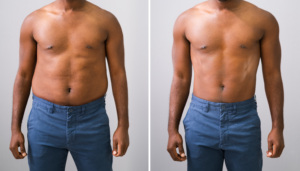Muscle Loss Due to Aging is a common condition that affects 10% of adults who are over 50 years old.
While it can decrease life expectancy and quality of life, there are actions you can take to prevent and even reverse the condition.
Although some of the causes of sarcopenia are a natural consequence of aging, others are preventable. In fact, a healthy diet and regular exercise can reverse sarcopenia, increasing lifespan and quality of life.
This article explains what causes sarcopenia, and lists many ways you can fight it.
What Is Sarcopenia?
Sarcopenia literally means “lack of flesh.” It’s a condition of age-associated muscle degeneration that becomes more common in people over the age of 50.
After middle age, adults lose 3% of their muscle strength every year, on average. This limits their ability to perform many routine activities.
Unfortunately, sarcopenia also shortens life expectancy in those it affects, compared to individuals with normal muscle strength.
Sarcopenia is caused by an imbalance between signals for muscle cell growth and signals for teardown. Cell growth processes are called “anabolism,” and cell teardown processes are called “catabolism”.
For example, growth hormones act with protein-destroying enzymes to keep muscle steady through a cycle of growth, stress or injury, destruction and then healing.
This cycle is always occurring, and when things are in balance, muscle keeps its strength over time.
However, during aging, the body becomes resistant to the normal growth signals, tipping the balance toward catabolism and muscle loss.
SUMMARY:
Your body normally keeps signals for growth and teardown in balance. As you age, your body becomes resistant to growth signals, resulting in muscle loss.
Four Factors That Accelerate Muscle Loss
Although aging is the most common cause of sarcopenia, other factors can also trigger an imbalance between muscle anabolism and catabolism.
Immobility, Including a Sedentary Lifestyle
Disuse of muscle is one of the strongest triggers of sarcopenia, leading to faster muscle loss and increasing weakness.
Bed rest or immobilization after an injury or illness leads to rapid loss of muscle (9Trusted Source).
Although less dramatic, two to three weeks of decreased walking and other regular activity is also enough to decrease muscle mass and strength.
Periods of decreased activity can become a vicious cycle. Muscle strength decreases, resulting in greater fatigue and making it more difficult to return to normal activity.
Unbalanced Diet
A diet providing insufficient calories and protein results in weight loss and diminished muscle mass.
Unfortunately, low-calorie and low-protein diets become more common with aging, due to changes in sense of taste, problems with the teeth, gums and swallowing, or increased difficulty shopping and cooking.
To help prevent sarcopenia, scientists recommend consuming 25–30 grams of protein at each meal.
Inflammation
After injury or illness, inflammation sends signals to the body to tear down and then rebuild the damaged groups of cells.
Chronic or long-term diseases can also result in inflammation that disrupts the normal balance of teardown and healing, resulting in muscle loss.
For example, a study of patients with long-term inflammation resulting from chronic obstructive pulmonary disease (COPD) also showed that patients had decreased muscle mass.
Examples of other diseases that cause long-term inflammation include rheumatoid arthritis, inflammatory bowel diseases like Crohn’s disease or ulcerative colitis, lupus, vasculitis, severe burns and chronic infections like tuberculosis.
A study of 11,249 older adults found that blood levels of C-reactive protein, an indicator of inflammation, strongly predicted sarcopenia.
Severe Stress
Sarcopenia is also more common in a number of other health conditions that increase stress on the body.
For example, people with chronic liver disease, and up to 20% of people with chronic heart failure, experience sarcopenia.
In chronic kidney disease, stress on the body and decreased activity lead to muscle loss.
Cancer and cancer treatments also place great stress on the body, resulting in sarcopenia.
SUMMARY:
In addition to aging, sarcopenia is accelerated by low physical activity, insufficient calorie and protein intake, inflammation and stress.
How to Tell If You Have Sarcopenia
The signs of sarcopenia are the result of diminished muscle strength.
Early signs of sarcopenia include feeling physically weaker over time, and having more difficulty than usual lifting familiar objects.
A hand-grip-strength test has been used to help diagnose sarcopenia in studies, and may be used in some clinics.
Decreased strength might show itself in other ways too, including walking more slowly, becoming exhausted more easily and having less interest in being active.
Losing weight without trying can also be a sign of sarcopenia.
However, these signs can also occur in other medical conditions. Yet if you experience one or more of these and can’t explain why, talk to a health professional.
SUMMARY:
Noticeable loss of strength or stamina and unintentional weight loss are signs of multiple diseases, including sarcopenia. If you are experiencing any of these without a good reason, talk to your doctor.
Exercise Can Reverse Sarcopenia
The strongest way to fight sarcopenia is to keep your muscles active.
Combinations of aerobic exercise, resistance training and balance training can prevent and even reverse muscle loss. At least two to four exercise sessions weekly may be required to achieve these benefits.
All types of exercise are beneficial, but some more than others.
Resistance Training
Resistance training includes weightlifting, pulling against resistance bands or moving part of the body against gravity.
When you perform resistance exercise, the tension on your muscle fibers results in growth signals that lead to increased strength. Resistance exercise also increases the actions of growth-promoting hormones.
These signals combine to cause muscle cells to grow and repair themselves, both by making new proteins and by turning on special muscle stem cells called “satellite cells,” which reinforce existing muscle.
Thanks to this process, resistance exercise is the most direct way to increase muscle mass and prevent its loss.
A study of 57 adults aged 65–94 showed that performing resistance exercises three times per week increased muscle strength over 12 weeks.
In this study, exercises included leg presses and extending the knees against resistance on a weight machine.
Fitness Training
Sustained exercise that raises your heart rate, including aerobic exercise and endurance training, can also control sarcopenia.
Most studies of aerobic exercise for the treatment or prevention of sarcopenia have also included resistance and flexibility training as part of a combination exercise program.
These combinations have been consistently shown to prevent and reverse sarcopenia, although it is often unclear whether aerobic exercise without resistance training would be as beneficial.
One study examined the effects of aerobic exercise without resistance training in 439 women over 50 years of age.
The study found that five days per week of cycling, jogging or hiking increased muscle mass. Women started with 15 minutes of these activities per day, increasing to 45 minutes over 12 months.
Walking
Walking can also prevent and even reverse sarcopenia, and it’s an activity most people can do for free, anywhere they live.
A study of 227 Japanese adults over 65 years old found that six months of walking increased muscle mass, particularly in those who had low muscle mass.
The distance each participant walked was different, but they were encouraged to increase their total daily distance by 10% each month.
Another study of 879 adults over age 60 found that faster walkers were less likely to have sarcopenia.
SUMMARY:
Exercise is the most effective way to reverse sarcopenia. Resistance training is best to increase muscle mass and strength. However, combination exercise programs and walking also fight sarcopenia.
Four Nutrients That Fight Sarcopenia
If you’re deficient in calories, protein or certain vitamins and minerals, you may be at higher risk of muscle loss.
However, even if you aren’t deficient, getting higher doses of some key nutrients can promote muscle growth or enhance the benefits of exercise.
Protein
Getting protein in your diet directly signals your muscle tissue to build and strengthen.
As people age, their muscles become more resistant to this signal, so they need to consume more protein to increase muscle growth.
One study found that when 33 men over age 70 consumed a meal containing at least 35 grams of protein, their muscle growth increased.
Another study found that a group of younger men only required 20 grams of protein per meal to stimulate growth.
A third study got seven men over the age of 65 to take daily 15-gram supplements of essential amino acids, the smaller building blocks of protein, which resulted in muscle growth.
The amino acid leucine is particularly important for regulating muscle growth. Rich sources of leucine include whey protein, meat, fish and eggs, as well as soy protein isolate.
Vitamin D
Vitamin D deficiency is related to sarcopenia, although the reasons why are not entirely understood.
Taking vitamin D supplements can increase muscle strength and reduce the risk of falling. These benefits have not been seen in all studies, possibly because some research volunteers may have already been getting enough vitamin D.
The best dose of vitamin D for preventing sarcopenia is currently unclear.
Omega-3 Fatty Acids
No matter how old you are, consuming omega-3 fatty acids via seafood or supplements will increase your muscle growth.
A study of 45 women found that a daily 2-gram fish oil supplement combined with resistance training increased muscle strength more than resistance training without fish oil.
Part of this benefit may be due to the anti-inflammatory benefits of omega-3 fatty acids. However, research has suggested that omega-3s might also signal muscle growth directly.
Creatine
Creatine is a small protein normally made in the liver. Although your body makes enough to prevent you from becoming deficient, creatine in the diet from meat or as a supplement may benefit your muscle growth.
A group of several studies investigated how taking a daily 5-gram creatine supplement affected 357 adults with an average age of 64.
When participants took the creatine, they got more benefits from resistance training compared to when they performed resistance training with no creatine.
Creatine is probably not beneficial for sarcopenia if used alone, without exercise.
SUMMARY:
Protein, vitamin D, creatine and omega-3 fatty acids can all improve muscle growth in response to exercise.
The Bottom Line
Sarcopenia, the loss of muscle mass and strength, becomes more common with age and can decrease lifespan and quality of life.
Eating enough calories and high-quality protein can slow down the rate of muscle loss. Omega-3 and creatine supplements may also help fight sarcopenia.
Nevertheless, exercising is the most effective way to prevent and reverse sarcopenia.
Resistance exercises appear to be particularly effective, including using resistance bands, lifting weights or doing calisthenics like squats, push-ups and sit-ups.
However, even simple exercises like walking can slow your rate of muscle loss. At the end of the day, the most important thing is to get active.
To learn more about reversing muscle loss,
See how Hormone Replacement Therapy and HGH Peptide therapies can help,
RenewFX Health and Wellness, Houston, Texas



